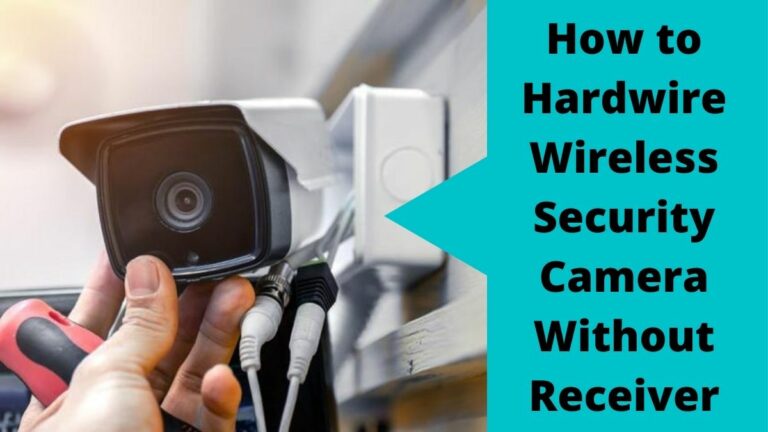Hardwiring a wireless security camera without receiver is hard to do, especially if you’re a beginner. However, in this blog post, you will know everything you need to hardwire wireless security cameras in the right way.
While wireless surveillance systems and cameras have a bunch of features that anyone loves to have but they are easy to damage, and the Wi-Fi devices can be hacked easier than wired ones.
So, for these reasons and many uncovered reasons, a lot of homeowners move to use wired cameras as they are reliable and work for a long time.
Even more, customers who purchased a WiFi camera before work on converting their wireless cameras to wired to enjoy wired system advantages.
Now, Let’s see
What is meant by Hardwire Wireless Security Camera?
Well, Hardwire wireless security camera is the process of converting wi-fi cameras to wired by using available wires, and cables on the market.
The changing steps mean that the wi-fi signal used by wireless surveillance cameras to transmit data between cameras and other devices will change by network cables, or Coaxial cables depending on your system type Analog or Digital.
Can I Hardwire Wireless Security Camera Without Receiver?
The answer is YES, you can hardwire your standalone wireless security camera and convert it to a wired one without needing a receiver, or video recorder.
But you should know hardwiring a single camera without any receiver could cause some issues such as you can’t store your camera videos for a long time as there’s no video recorder device to save footage unless you have a wireless cam with SD card.
Now,
How to HardWire Wireless Security Camera Without Receiver?
Before you start at a hardwire wireless security camera without receiver you have to make sure that your wifi camera is an IP camera with an additional pigtail.
The pigtail is used as an alternative way to connect wireless cameras with other devices through wires. It consists of 2 separate cables, one for power, and the second for LAN port.
For more let’s see the step by step process
Step1: Disconnect the Camera from the Receiver
To avoid interference between signals you have to disconnect your wireless camera from the receiver whether it’s NVR or Wifi router.
Open the camera application on your mobile if installed, login into your account, then go to the list of devices and click on your camera to disconnect it.
If not, you can disconnect the wireless camera from the NVR also.
Step2: Reset the Camera
The next step to a hardwire wireless security camera without receiver is to reset the camera.
Resetting the cam will remove the previous setting such as wifi username and password.
You can reset your camera by opening the camera app and choosing the RESET option, or you can do it by using a hardware button on the back, or side of the camera.
Step3: Measure the Distance between the Devices
For wireless surveillance systems, one of its benefits is you don’t need to measure or run wires for each device in the system.
Once the system is mounted in the Wifi range that means your cameras will be connected automatically when you turn on the camera.
As we mentioned above, to hardwire wireless security camera without receiver you have to connect the camera with wires, and cables.
So, to do this you have to measure the exact length for the distance between the wireless camera to the other device.
For example, if you do this to connect wireless security to a computer, or switch then you have to measure the accurate distance between camera location and the PC.
Step4: Install the camera
Now, you finish measuring, the next is the installation of the wireless camera in its new location.
As Wi-Fi cameras placements are tightly controlled by WIFI range so most people mount cams in spots near to wifi router.
However, you can install the wireless camera in a new place or keep it in the same place without any change.
For your knowledge, Ethernet cables used in PoE systems with NVR can transmit signals for up to 100 meters or 328 feet, while coaxial cable sends more than Ethernet cable, it sends up to 500m or 1640 feet.
So, you have the freedom to put your network IP camera in any place you want as long as you measure and bring the suitable length for the new spot.
Step5: Connect The Camera, And Run The Wires
Nothing is more important In hardwiring wireless security cameras without a receiver process than this step.
Doing this step guarantees your wireless security camera will work 24/7 without any issue in connections or stop due to wiring problems.
So, before you start to run wires of wireless camera you have to ensure that the below items is available
1- Camera location near the power outlet.
2- There is the ability to hide security camera wires under eaves, or in the ground.
3- Wire routes have no bending or obstruction that may affect the transmitting efficiency of the wires and cables.
4- In case you mount your cam outside your home, you must ensure that wires are protected from rains, and dust like cameras.
5- Aside from the wireless camera cable, the sending device must have enough LAN ports for feature usage.
6- Lastly, make sure that your wire is working normally before running it by using Cable Tester, and also ensure that you leave a spare in wires from both sides.
By applying the above rules you will get a successful hardwiring process for your wireless security camera.
Step6: Turn on the camera
After we proceed to the serious steps on how to hardwire a wireless camera without receiver we reach the final step which is turning on the cam and testing it.
Plug the camera power adapter in the electric source that is available near it, if there are no available power outlets you can purchase an extension cord.
Move to the camera body and turn the camera on, wait until the light of the camera flashes and indicates that it’s working. Then open the mobile app and start to link your wireless camera to the phone to ease the process of controlling your camera.
For remote viewing, make sure that your home network router provides high-speed internet to enable you to view and take action immediately when something wrong happens.
Conclusion
Finally, Hardwiring a wireless security camera without a receiver is a good thing to do as a protecting step for your system from being damaged or hacked.
You can do the hardwiring process step by step if you’re a beginner. If not and you have enough experience to deal with wiring and running cables of wired cameras, then you start from any step you want and execute it to the end of the installation.
Resources: Itstillwork


HELLO Marvin, I have an 8 cam Xmarto system w/DVR. I chose xmarto because I lived remote w/o wi fi and Xmarto offered a dvr with its own wifi/router.
I also purchased a seperate Xmarto Cam with tilt,etc. To replace one w/o.
It never worked well,I tried to replace antenna W/ a longer reach but found that this cam antenna was fixed.The xmarto rep I spoke with was rude and insisted all. Cams had replaceable antennas.I explained that I had replaced several on my existing cams so I knew how.I finally gave up. My question is….now I have Starlink… will this Cam actually work and if I hard wire to nvr first will it work wi fi to nvr? I can not run wire to NVR thanks SO much for any reply.
Hey Harlee,
To be honest, I don’t use Xmarto cameras before, But here is my advice that will help you solve your issue with the camera
1- Use the mobile app to see if the standalone camera work on Wi-Fi without being connected to the system or not.
2- Try to connect the camera with wires to the DVR and from the display screen of the DVR/NVR see the camera feed.
3- Instead of replacing the antenna of the camera you can purchase a Wi-Fi extender device to feed your camera with an internet signal.
4- Read the camera manual and check if the camera has the capability to be linked with Xmarto systems or if it works alone.
Apply the above methods and see the result, and if there’s another issue don’t hesitate to contact Us. Thanks